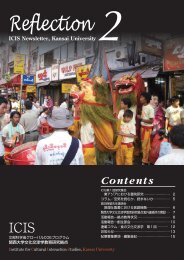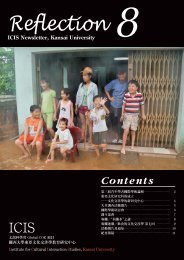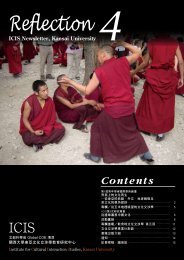English
English
English
You also want an ePaper? Increase the reach of your titles
YUMPU automatically turns print PDFs into web optimized ePapers that Google loves.
ICIS Newsletter, Kansai University<br />
< Session 2 ><br />
Negotiating the Self and the Otherness<br />
on the Interface of Cultures<br />
Cases of Baba Chinese, Native Taiwanese,<br />
and Yunnan Muslim Immigrants<br />
Interculturalism, Empire and the Nation-State:<br />
A Portrait of the Lim Cheng Ean Family<br />
Neil KHOR Jin Keong(Faculty of History, University of Malaya)<br />
Identity heterogeneity of the strait Chinese in Penang, Malaysia,<br />
is discussed through the life history of the Lim Cheng Ean family.<br />
Lim Cheng Ean and his wife were educated in England and<br />
embodied British culture. Their children also received an education<br />
in the typical heterogeneous environment of Penang and succeeded<br />
in politics and medicine. The heterogeneous identity of colonial<br />
Penang is identifiable in all generations.<br />
Facing Japanese: Colonialism, Modernization, and<br />
Epidemic Liver Disease in the Truku Society, 1895–1945<br />
Umin Itei (Department of Anthropology, University of Hawaii, Manoa)<br />
The incidences of liver disease rapidly<br />
increased in Truku society in Taiwan during<br />
the period of Japanese colonization (1895–<br />
1945). The colonial structure’s influence on<br />
epidemic liver disease in Truku society is<br />
discussed through observations of the<br />
Japanese colonial structure’s influence on<br />
Taiwanese culture and politics, outbreak of epidemic liver disease in<br />
Truku society, the reality of Japanese colonialism, aboriginal policy,<br />
and settlers’ awareness of the tropics.<br />
Managing the Image of ‘Yi di (Barbarian Area)’: From<br />
the Case Study of Spirit Possession among Yunnanese<br />
Muslim Migrants in Myanmar<br />
KIMURA Mizuka(COE-PD, ICIS, Kansai University)<br />
Yunnanese Muslims who immigrated to<br />
Myanmar are trying to understand the<br />
phenomena of spirit possession from two<br />
standards: Chinese and Islam. One of the<br />
reasons that spirit possessions occur is<br />
Upper Myanmar’s characteristic of a<br />
“barbarian Area” inhabited by indigenous<br />
people. On the other hand, in terms of handling spirit possession,<br />
the symbolized “barbarian Area” is released outside of communities<br />
using the power of Islam. The relationships between Yunnanese<br />
Muslims and others are discussed through the discourse of spirit<br />
possession.<br />
Comments<br />
TAN Chee-Beng<br />
(Department of Anthropology, Chinese University of Hong Kong)<br />
Each presentation discusses cultural<br />
reproduction through multi-ethnic and multireligious<br />
relationships with others. The<br />
papers by Neil KHOR and KIMURA used<br />
“heterogeneity” as key concepts, but since<br />
the nature of culture is essentially<br />
heterogeneous, the use of such a concept is<br />
meaningless. The paper by Umin Itei discusses the outbreak of liver<br />
disease only based on documents from the colonial government, while<br />
the voices of the indigenous people are not reflected in the paper.<br />
< Session 3 ><br />
Diverse Aspects of Translation:<br />
Buddhism, Islam, and Wikipedia<br />
The Formation and Development of the Chinese Buddhist<br />
Literature<br />
MIYAJIMA Junko(COE-RA, ICIS,Kansai University)<br />
The translating of Buddhist literatures into<br />
Chinese started by a corporation of inner-asia<br />
Buddhists and Chinese people. There were<br />
disputes over whether to focus on beautiful<br />
literary expressions (literature group)or to<br />
focus on conveying accurate meaning<br />
(quality group). The literature group was<br />
originally made up of Chinese, and the quality group was made up of<br />
monks from the western regions, but as translations of Buddhist<br />
literature progressed, the Chinese started pursuing quality while the<br />
western monks began to incline toward literature. Such a phenomenon<br />
of the reversal of roles reflects the process of mutual understanding<br />
and self-transformation in translation.<br />
Transformation of Changes in the Translation of Terminology<br />
by Chinese Muslim Intellectuals : Is God Shangdi?<br />
SATO Minoru (COE Fellow, ICIS, Kansai University)<br />
When the publication of Islamic literature in<br />
Chinese language had started in China, the<br />
concepts of god in Islam and shangdi<br />
(supreme being)and tian (heaven)in China<br />
were treated as completely different concepts.<br />
Gradually, however, people began to regard<br />
shangdi and tian the same as god in Islam and<br />
started claiming that the traditional Chinese ideology and Islamic<br />
teachings shared the same origin. The ideology, which claimed that China<br />
and Islam shared the same origin, later spread widely among Chinese<br />
Muslims. Behind it there is a philosophy of translation that translation is<br />
difficult, but the meaning is communicable.<br />
3












